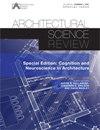正能量建筑中的能量平衡和光伏集成。建筑办公室案例研究中的设计和性能
IF 1.8
3区 艺术学
0 ARCHITECTURE
引用次数: 4
摘要
本文分析了当前正能量建筑(PEB)的定义,并结合实际监测数据选择了NZEB和PEB建筑项目,讨论了它们的设计特点和实现正能量平衡的潜力。该研究旨在评估办公大楼中光伏(PV)面积与自给率之间的最佳比例。研究表明,大多数建筑物的光伏系统的面积等于总建筑净面积的10-20%。光伏面积比在13%到20%之间的建筑,可以实现100%到150%的自给自足。光伏在农村的安装对达到正能量平衡起着决定性的作用。在研究的建筑中,安装在立面上的光伏系统与安装在屋顶上的光伏系统的比例从50%到57%不等。总体水平辐射(GHI)较高的建筑PV面积比往往较低。本文章由计算机程序翻译,如有差异,请以英文原文为准。
Energy balance and photovoltaic integration in positive energy buildings. Design and performance in built office case studies
ABSTRACT This paper analyses the current definition of positive energy building (PEB) and a selection of both NZEB and PEB built projects with real monitored data, discussing their design features and potential for achieving positive energy balance. The research aims to assess an optimal ratio between photovoltaic (PV) area and achieved self-sufficiency ratios in office buildings. The study shows that most of the buildings’ PV systems have an area equal to 10–20% of the total building’s net floor area. Buildings that have PV to area ratio from 13% to 20% are self-sufficient from 100% to 150%. PV installation in the façades results decisive for reaching positive energy balance. The relation of the PV system installed on the façade to PV system on the roof is from 50% to 57% for the studied buildings. Buildings located in sites with higher global horizontal irradiation (GHI) tend to have lower PV area ratios.
求助全文
通过发布文献求助,成功后即可免费获取论文全文。
去求助
来源期刊

Architectural Science Review
ARCHITECTURE-
CiteScore
4.80
自引率
8.70%
发文量
34
期刊介绍:
Founded at the University of Sydney in 1958 by Professor Henry Cowan to promote continued professional development, Architectural Science Review presents a balanced collection of papers on a wide range of topics. From its first issue over 50 years ago the journal documents the profession’s interest in environmental issues, covering topics such as thermal comfort, lighting, and sustainable architecture, contributing to this extensive field of knowledge by seeking papers from a broad geographical area. The journal is supported by an international editorial advisory board of the leading international academics and its reputation has increased globally with individual and institutional subscribers and contributors from around the world. As a result, Architectural Science Review continues to be recognised as not only one of the first, but the leading journal devoted to architectural science, technology and the built environment. Architectural Science Review publishes original research papers, shorter research notes, and abstracts of PhD dissertations and theses in all areas of architectural science including: -building science and technology -environmental sustainability -structures and materials -audio and acoustics -illumination -thermal systems -building physics -building services -building climatology -building economics -ergonomics -history and theory of architectural science -the social sciences of architecture
 求助内容:
求助内容: 应助结果提醒方式:
应助结果提醒方式:


